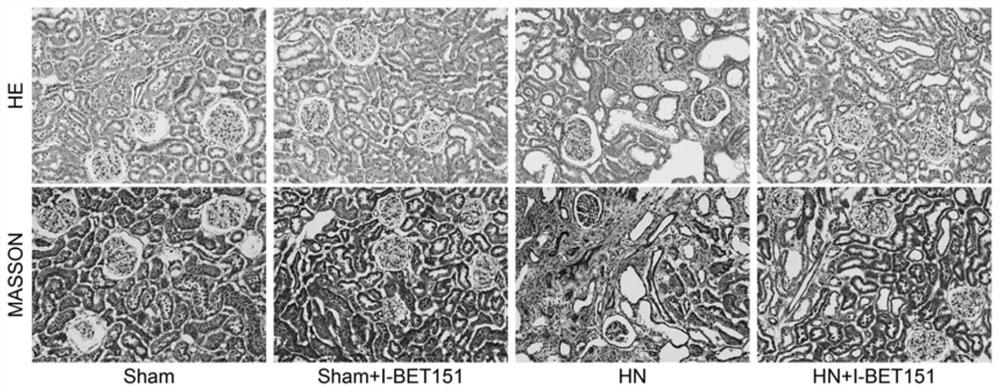Drug for treating uric acid nephropathy
A technology of uric acid nephropathy and medicine, which is applied in the field of medicine for treating uric acid nephropathy, can solve the problems of obvious toxic and side effects, renal failure, etc., and achieve the effect of obvious toxic and side effects, no toxic and side effects, and remarkable effect
- Summary
- Abstract
- Description
- Claims
- Application Information
AI Technical Summary
Problems solved by technology
Method used
Image
Examples
Embodiment 1
[0033] Example 1 Construction of an animal model of uric acid nephropathy
[0034] Twenty-four male SPF-grade SD rats, 8 weeks old, weighing 200-220 g, and adaptively fed for 7 days were randomly divided into 4 groups, each with 6 rats.
[0035] (1) Preparation of rat uric acid nephropathy model
[0036] According to the weight of the rat, the ratio of adenine 0.1g / Kg and potassium oxazinate 1.5g / Kg was mixed with distilled water to make a suspension with a final concentration of 80g / L, and the final concentration was 20ml / kg / d. Gavage twice a day for 21 consecutive days to induce renal fibrosis in rats with uric acid nephropathy. All animal experiments comply with China's regulations on the management and use of experimental animals.
[0037] (2) Experimental grouping
[0038] Inhibitor I-BET151 solution: Dissolve dimethyl sulfoxide (DMSO) in PBS to make 0.1% DMSO, and then dissolve 30 mg / kg of I-BET151 in 50 μl of 0.1% DMSO.
[0039] a. sham group (sham operation group, n=6)
Embodiment 2
[0044] Example 2 Collection of blood samples and detection of biochemical indicators
[0045] Fasting for 12 hours before blood collection, taking 2ml blood from the inner canthal vein or intraperitoneal injection of 3% pentobarbital sodium at a dose of 1ml / kg according to the weight of the rat, and then taking 5ml blood from the abdominal aorta after anesthesia. Centrifuge at 2500 rpm at room temperature for 15 minutes, and transfer the serum to a sterile Eppendorf tube, and freeze the blood biochemical indicators to be tested at -80°C. The blood samples and urine samples of the rats in each group in Example 1 were measured by an automatic biochemical analyzer for blood creatinine, blood urea nitrogen, and urine microalbumin. The result is figure 1 Shown.
[0046] figure 1 A shows: Compared with the sham group, the serum creatinine (Scr) level of the HN model group increased. After I-BET151 was injected, the Scr decreased significantly (p <0.05), indicating that injection of I-BET
Embodiment 3
[0049] Example 3 Observation of kidney tissue morphology
[0050] The rat kidney tissues of each group obtained in Example 1 were taken and fixed with 4% paraformaldehyde. Conventional gradient ethanol dehydration, transparent xylene, paraffin embedded, 4μm continuous paraffin sections, and HE and Masson staining to observe the pathological changes of kidney tissue. Observation of renal tubulointerstitial infiltration, renal thickness, and degree of fibrosis under light microscope were evaluated by Image-Pro-Plus software.
[0051] The result is figure 2 Shown: HE staining results show that the renal interstitial area inflammatory cells infiltrate in the HN model, renal tubules are dilated, and the lesions are significantly reduced after I-BET151 treatment; Masson staining results show that compared with the sham group, the HN model shows renal interstitial fibrosis The blue-stained area where the main component is extracellular matrix such as collagen increased significantly, indic
PUM
 Login to view more
Login to view more Abstract
Description
Claims
Application Information
 Login to view more
Login to view more - R&D Engineer
- R&D Manager
- IP Professional
- Industry Leading Data Capabilities
- Powerful AI technology
- Patent DNA Extraction
Browse by: Latest US Patents, China's latest patents, Technical Efficacy Thesaurus, Application Domain, Technology Topic.
© 2024 PatSnap. All rights reserved.Legal|Privacy policy|Modern Slavery Act Transparency Statement|Sitemap



